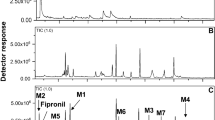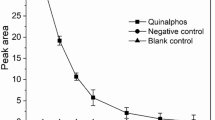Abstract
The fungus Cunninghamella elegans is a useful model of human catabolism of xenobiotics. In this paper, the biotransformation of fluorinated biphenyls by C. elegans was investigated by analysis of the culture supernatants with a variety of analytical techniques. 4-Fluorobiphenyl was principally transformed to 4-fluoro-4′-hydroxybiphenyl, but other mono- and dihydroxylated compounds were detected in organic extracts by gas chromatography–mass spectrometry. Additionally, fluorinated water-soluble products were detected by 19F NMR and were identified as sulphate and β-glucuronide conjugates. Other fluorobiphenyls (2-fluoro-, 4,4′-difluoro- and 2,3,4,5,6-pentafluoro-biphenyl) were catabolised by C. elegans, yielding mono- and dihydroxylated products, but phase II metabolites were detected from 4,4′-difluorobiphenyl only.




Similar content being viewed by others
References
Asha S, Vidyavathi M (2009) Cunninghamella—a microbial model for drug metabolism studies—a review. Biotechnol Adv 27:16–29
Boersma FGH, McRoberts WC, Cobb SL, Murphy CD (2004) A F-19 NMR study of fluorobenzoate biodegradation by Sphingomonas sp HB-1. FEMS Microbiol Lett 237:355–361
Carvalho MF, Ferreira MIM, Moreira IS, Castro PML, Janssen DB (2006) Degradation of fluorobenzene by Rhizobiales strain F11 via ortho cleavage of 4-fluorocatechol and catechol. Appl Environ Microbiol 72:7413–7417
Cerniglia CE, Freeman JP, Mitchum RK (1982) Glucuronide and sulfate conjugation in the fungal metabolism of aromatic hydrocarbons. Appl Environ Microbiol 43:1070–1075
Cerniglia CE, Miller DW, Yang SK, Freeman JP (1984) Effects of a fluoro substituent on the fungal metabolism of 1-fluoronaphthalene. Appl Environ Microbiol 48:294–300
Dietrich D, Hickey WJ, Lamar R (1995) Degradation of 4, 4′-dichlorobiphenyl, 3, 3′, 4, 4′-tetrachlorobiphenyl, and 2, 2′, 4, 4′, 5, 5′-hexachlorobiphenyl by the white-rot fungus Phanerochaete chrysosporium. Appl Environ Microbiol 61:3904–3909
Dodge RH, Cerniglia CE, Gibson DT (1979) Fungal metabolism of biphenyl. Biochem J 178:223–230
Ferreira MIM, Marchesi JR, Janssen DB (2008) Degradation of 4-fluorophenol by Arthrobacter sp. strain IF1. Appl Microbiol Biotechnol 78:709–717
Green NA, Meharg AA, Till C, Troke J, Nicholson JK (1999) Degradation of 4-fluorobiphenyl by mycorrhizal fungi as determined by F-19 nuclear magnetic resonance spectroscopy and C-14 radiolabelling analysis. Appl Environ Microbiol 65:4021–4027
Isanbor C, O'Hagan D (2006) Fluorine in medicinal chemistry: a review of anti-cancer agents. J Fluorine Chem 127:303–319
Jeschke P (2004) The unique role of fluorine in the design of active ingredients for modern crop protection. Chembiochem 5:570–589
Kamei I, Kogura R, Kondo R (2006) Metabolism of 4, 4′-dichlorobiphenyl by white-rot fungi Phanerochaete chrysosporium and Phanerochaete sp MZ142. Appl Microbiol Biotechnol 72:566–575
Key BD, Howell RD, Criddle CS (1997) Fluorinated organics in the biosphere. Environ Sci Technol 31:2445–2454
Moody JD, Zhang D, Heinze TM, Cerniglia CE (2000) Transformation of amoxapine by Cunninghamella elegans. Appl Environ Microbiol 66:3646–3649
Murphy CD (2007) The application of F-19 nuclear magnetic resonance to investigate microbial biotransformations of organofluorine compounds. Omics 11:314–324
Murphy CD, Quirke S, Balogun O (2008) Degradation of fluorobiphenyl by Pseudomonas pseudoalcaligenes KF707. FEMS Microbiol Lett 286:45–49
Murphy CD, Clark BR, Amadio J (2009) Metabolism of fluoroorganic compounds in microorganisms: impacts for the environment and the production of fine chemicals. Appl Microbiol Biotechnol 84:617–629
Parkinson A, Safe S (1982) Cytochrome P-450-mediated metabolism of biphenyl and the 4-halobiphenyls. Biochem Pharmacol 31:1849–1856
Zhang DL, Yang YF, Leakey JEA, Cerniglia CE (1996) Phase I and phase II enzymes produced by Cunninghamella elegans for the metabolism of xenobiotics. FEMS Microbiol Lett 138:221–226
Acknowledgement
The authors acknowledge financial assistance from the Environmental Protection Agency STRIVE Programme.
Author information
Authors and Affiliations
Corresponding author
Rights and permissions
About this article
Cite this article
Amadio, J., Murphy, C.D. Biotransformation of fluorobiphenyl by Cunninghamella elegans . Appl Microbiol Biotechnol 86, 345–351 (2010). https://doi.org/10.1007/s00253-009-2346-4
Received:
Revised:
Accepted:
Published:
Issue Date:
DOI: https://doi.org/10.1007/s00253-009-2346-4




